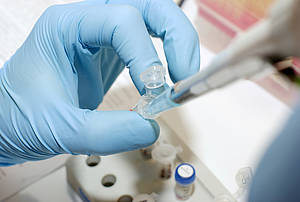BACKGROUND INFORMATION
Emergence of personalised medicine
 |
In 2003 after more than a decade of work, the human genome was sequenced, mapping the estimated 22,000 protein-coding genes that humans possess. This opened the way to identifying specific genes that are involved in particular diseases, and pinpointing the variations in a person’s genetic make-up that predisposes that person to a given disease, or makes it more likely that someone will respond better to one type of treatment rather than another. This was the beginning of the first ‘omics’ technology and initiated a novel research field, the one based on the genes: genomics.
It turns out however, that knowing a genetic sequence itself is only of partial use to inform on the predisposition for disease or the heterogenic response to treatment. Except in a few particular monogenic or ‘single gene’ diseases, one gene alone is not the ultimate predictor. What is more pertinent is to know which proteins and other key molecules are actually manufactured by specialised groups of cells. These characteristics are termed the ‘cellular phenotype’, the actual observable traits of an organism, as opposed to the genetic make-up, or genotype of the organism.
An overview of the diseased cell’s phenotype is the important goal of personalised medicine: the traits that a cell actually exhibits in terms of quantifiable alterations in the expression of molecules such as proteins, carbohydrates, lipids or metabolites. In this regard, proteomic, glycomic, lipidomic and metabolomic profiling provide a picture of the cell that is much closer to the disease than genetic profiling alone. The science of elucidating these properties is collectively referred to as ‘omics’ and integration between all these omics is vital. To be well implemented, this integration needs to be well prepared and we propose to start the exercise in this Forward Look.
New insights from these technology and informatics disciplinary areas will drive medicine from finding cures for diseases much more towards individualised prediction, diagnosis, treatment and prevention of diseases. Indeed, individualised biological profiles will be used to determine a person’s individual healthcare needs and this is the paradigm shift termed ‘personalised medicine’.
Personalised medicine today
Almost all diseases have a genetic component: we are born with a genome that imbues us with a certain risk of disease. The earlier we can detect and quantify this risk, the earlier we can intervene. The rapid developments in biomedical research can thus enable a revolution in health care.
Today the application of new knowledge in the form of personalised medicine is still in its infancy. With pharmacogenomics, the tailoring of pharmaceutical treatment to an individual genome profile, the omics have started delivering a handful of results for medical applications with mixed successes. The most impressive outcomes appear in the field of molecular oncology with the treatment of cancer tumours. Important milestones are also being achieved in the detection and identification of psychiatric disorders like schizophrenia and Alzheimer’s disease via pharmacogenetic tools.
Another important application of more precise ‘omic’ knowledge lies in the side-effects of drugs. Today, there are highly effective drugs, developed at great expense, which are not approved for use due to adverse side effects in parts of the population. Genomics and other omics can help predict who will be prone to adverse side-effects, enabling more precise prescription and use of alternative medication, thus impacting patient’s well-being and having a large impact on the underlying billions of Euros spent in drug development costs.
However, the cost-benefit ratio of molecular profiling such as genomics is generally still rather unfavourable and could therefore prevent the development of its applications. In addition, the genetic basis of disease is far more complicated than originally expected, and there is a long way to go to actual clinical application. In other words, two people might have identical gene sequences, but in one person the gene has been modified by external factors, such as diet, so that it is less densely packed into chromatin, that makes it healthy while the other person’s gene is packed more densely, rendering it ‘unhealthy’. Simple gene sequencing will not distinguish between the two.
So clearly there remains still much to be understood before the new knowledge can be translated safely into general healthcare. It is even unclear in what way we can determine whether knowledge can be used; given the individualised nature of findings, clinical trials as we know them today may not be the best instrument. The present Forward look will help describe these challenges and generate a research agenda with appropriate recommendations to bring appropriate solutions.
Future challenges
The challenges ahead are significant, and it is becoming clear that biological systems operate in a far more complex way that we might have previously thought. Nevertheless and as briefly described above, this molecular-based approach is starting to yield results. Ultimately it is predicted that these technologies will generate innovative therapies, limit adverse effects of treatments, increase the quality of clinical care, create an optimal fit between a patient and a treatment, and decrease the costs of healthcare. The characteristics and selected areas with particular relevance to personalised medicine are listed below:

- Omics & research data
An important characteristic of the omics revolution is the amount of data that the science is producing, managing and storing. The life sciences are becoming ‘big science’ – traditionally the preserve of fields such as atomic physics. DNA sequencing studies are already producing petabytes of data each year, a similar amount of data that the Large Hadron Collider is expected to produce annually. And in the same way that big atomic physics requires international collaboration to develop and run the technology and infrastructure, so will big biology.
This production of such vast amounts of data is changing the way that science is approached and this Forward Look will have to specifically investigate this challenge. In the past a researcher would design an experiment, take several months typically to carry it out, then interpret the results in a few days. Now, it takes a few days to complete an experiment and generate a lot of data, but several months to figure out what the data might mean. This is because of the complexity of biological systems. A living cell behaves ‘non-linearly’: one input into the system can produce multiple outputs. Untangling and relating these outputs is far from trivial.
A key aspect of the omics revolution is therefore the gathering, processing and interpretation of data. This is the field of bioinformatics, and it is a recurring theme across the life sciences in the information technology age that a new generation of bioinformaticians is desperately needed. Moves are being made in this direction by initiatives such as ELIXIR, spearheaded by the European Bioinformatics Institute (EBI), whose mission is “to construct and operate a sustainable infrastructure for biological information in Europe to support life science research and its translation to medicine and the environment, the bio-industries and society.”
While this wealth of information is being generated in laboratories, it is key that we can distinguish between good information and ‘noise’ before things move into the clinic: clinicians require not more data, but less. It will be an absolute prerequisite to use standardised protocols and to independently validate the results for comparability. Some criteria on standards have for example been published in proteomics, but these are fairly basic. It will therefore be important for the Forward Look to propose concrete solutions so that standardised protocols are established and validated as the area expands.

- Basic research & technologies
One key aspect towards personalised medicine is the rapidity with which the technology is advancing and the costs falling. The sequencing of the human genome took a decade and cost billions of dollars. Now, it is possible to generate the same data within hours and at a fraction of the cost. In a few years it is estimated that it will cost only 1000 Euros to sequence a person’s complete genome. Surveys of the public have shown that if the cost of sequencing falls to a sufficiently low level, almost everyone would like to see a sequence of their own genome.
The technology is available that would permit large numbers of the population to be screened at the proteomic level, for example. To do this would need integrated platforms for proteomics investigations, with robotics and semi automatic data analysis and experts will be consulted as part of this Forward Look to ensure integration is optimal.
Similarly, the various omics all require relatively large quantities of cellular material. The recent discovery of induced pluripotent stem cells could for example have an important role to play in this field, where specific cell types could be prepared under laboratory conditions.

- Translational research & biomarkers
It seems likely that to gain a meaningful individual profile of a person, several of these omics measurements would need to be integrated to yield accurate ‘biomarkers’ of a given state of the person’s personal physiological and biochemical profile.
One of the key goals of omics research is to identify such biomarkers – molecules whose altered expression and/or modifications provide information about the status of a cell or tissue. Large numbers of potential biomarkers have already been identified but it has been difficult to assign to them diagnostic significance. So one question that should be asked in this Forward Look is whether research effort should go into identifying yet more biomarkers or should priority be placed on ascribing a clinically useful diagnostic role for the existing markers that have been discovered.
 |
- Clinical research & diseases
While omics technologies produce large amounts of data, they also require large inputs of data. For example to analyse the patterns of mutations in cancer tumours, large numbers of patients are needed. This requires many centres to operate together.
It is a feature of the area generally that while many interesting and potentially important studies have been carried out, these have generally been done on small numbers of samples. There is a need to confirm the results that have been coming out of these studies – results from smaller studies could be integrated, and bigger studies are needed in the form of clinical trials. Because trials are expensive it would be important to prioritise the main problem areas towards which clinical trials should be directed. Knowledge gathered in a recent MED (formerly EMRC) Forward Look on Investigator-Driven Clinical Trials will of great value to look at this issue for personalised medicine in this new Forward Look.

- Societal impact of personalised medicine
The impact of personalised medicine on society might be quite radical; the increased transparency of individual biological inequalities will affect basic issues such as risk, responsibility, and solidarity, raising complex social and ethical questions. People with unfavourable molecular profiles might have to pay more for health insurance, might suffer from discrimination on the labour market or in the health care system, and might be personally blamed for not acting upon the information about their health risks.
It is already obvious that the major barrier for the latest ground-breaking technologies is economical. Who will pay for this technology to be developed – what will the role of the state versus commercial enterprises be? Indeed will the outcome be worth the expense? Should health care systems pay the cost of those innovative tools or should patients be directly involved as partners with their health insurances? What will the ultimate benefits be to society? Could this money be better directed at other big challenges such as malaria, education or multiple other options for improving the life of the citizen? The prediction is that the cost of these technologies will first raise the cost of health care but ultimately personalised medicine through early risk detection, better prevention, diagnosis, prevention, and treatment will reduce these costs. Given that it should result in an improved cost-effectiveness of health care, providing better health for less money, the Forward Look will have to explore the economics of personalised medicine.
Pharmaceutical industry has a key role in developing applications. Systems biology will become crucial to the drug discovery process: it will provide a powerful tool for identifying the specific proteins that will be effective drug targets, and will reveal – before the long and expensive clinical trials – the nature of a new drug’s side effects. Most diseases are biologically so complex that the chances of identifying effective drug targets without systems approaches are quite small. Yet the pharmaceutical industry is not much engaged in the systems biology paradigm. Indeed, drug companies, with their blockbuster-based business model and their narrow functional “silos” are not suited to the cross-functional demands of systems biology. Furthermore, legal and regulatory frameworks together with financial incentives (for example health insurance) are not aligned to stimulate this approach. As a result, the discovery process is suboptimal, to put it mildly, and great opportunities are missed that could be highlighted by the Forward Look proposed here.
There are also important social, regulatory, legal, ethical and moral issues to consider in this Forward Look around health insurance, and use and ownership of the data that will derive from molecular profiling of citizens. Do they belong to patients and at the same time should they be available for the medical care system for obvious patient benefits but restricted from private insurances, banks or employers? Differences between different countries on issues of health care systems and health insurance, but also culture, might become an issue for widespread acceptance of this technology.
There are wider societal issues about the moral, ethical and legal acceptability of molecular screening technologies across the population. This acceptability can further be predicted to impact population as a whole and within sub-groups of the populations such as religious, racial or ethnic groups. This crystallised in 2005 with the approval by the FDA (U.S. Food and Drug Administration) of BiDil, the first race-based medicine to treat congestive heart failure in African-Americans.
Indeed an important issue for the Forward Look will be the public perception of personalised medicine. The new developments are likely to raise both unrealistic expectations and anxiety, and hence open avenues to misunderstanding and even misinformation. Increased risk perception might lead to anxiety at the individual level – what to do with the information about your risks, especially if there is no cure yet? The risk is to replace uncertainty by more uncertainty and add to the complexity of health. The best remedy would be an enlightened public.
It is important that all European citizens are aware of what personalised medicine is and will be; what it can and cannot do. How does personalised medicine create new, individualised expectations and concepts of health? Which information is to be told to the population about their expectations of health care? To what extent will personalised medicine blur and refashion the boundary between medical experts and lay persons, especially with the emergence of internet? What kind of relationship/tension will there be between the traditional standard health care and the individual drift to personalised treatment and prevention? Prevention is closely related to early intervention and lifestyle management, requiring a rather different set-up of the health care system, which will have to become more patient-centred, individualised, and information-intensive. This will require changes in the education of health professionals and citizens that will have to be addressed by the Forward Look.
A crucial issue is therefore the proper communication between scientists, health care providers, patients and health insurance providers, who all need to understand what they are dealing with in order to define their roles and responsibilities.
It will be important to study in this Forward Look the spin-offs of these developments, their larger implications for the understanding of self, personhood, population, and ancestry, and the ways in which they implicate both the public and various kinds of omics research, including several disciplines in the humanities realm such as anthropology, ethics and philosophy. How does personalised medicine affect our identity as persons and as biological organisms, and what are its implications for our moral outlook?

